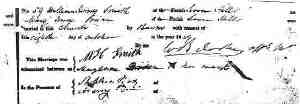
William Henry Smith (Cir 1785-) |
William Henry Smith
Noted events in his life were: • fact. William married Mary Ann Parker (Alias Wilcox), daughter of Edward Wilcox and Ann Parker, on 8 Oct 1839 in St Johns C of E, Parramatta, Sydney, NSW Australia. (Mary Ann Parker (Alias Wilcox) was born on 10 Apr 1789 in Bow, Devonshire England, christened on 10 Apr 1791 in Devon England, died on 13 Jul 1865 in Seven Hills, Sydney, NSW Australia and was buried on 15 Jul 1865 in St Johns C of E Cemetery, Parramatta, Sydney NSW Australia.) |